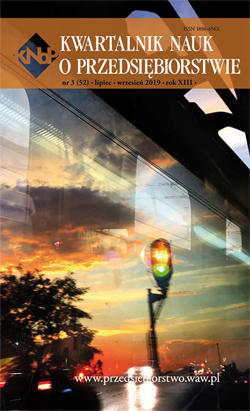Tworzenie wartości dodanej na bazie kontekstowych aplikacji mobilnych (przypadek branży turystycznej)
Abstrakt
W artykule przedstawiono analizę systemu cyfrowego zorientowanego na użytkownika i uzasadniono jego znaczenie w procesie tworzenia wartości. Celem badania jest wskazanie roli mobilnych aplikacji kontekstowych w marketingu turystycznym. Dokonano tego w toku przeglądu literatury istniejących badań i demonstracji przykładowych zastosowań w warunkach ruchu turystycznego. Wskazano, w jaki sposób cyfrowe systemy kontekstowe wzbogacają zestaw narzędzi marketingowych.
Full Text
Bibliografia
Bradley N., Dunlop M. (2004), Towards a User-centric and Multidisciplinary Framework for Designing Context-aware Applications, http://core.kmi.open.ac.uk/display/9015638, dostęp: 12.02.2019.
Bradley S. (2010), Designing for a Hierarchy of Needs, “Smashing Magazine”, https://bit.ly/2SZCLdE, dostęp: 5.02.2019.
Briscoe G., De Wilde P. (2006), Digital Ecosystems, in: Conference on Bio Inspired Models of Network, Information and Computing Systems, IEEE Press.
Carlsson C., Walden P. (2010), Supporting Tourists at the Bomarsund Fortress with a Mobile Value Service, “Journal of Information Technology Theory and Application”, Vol. 11(1), p. 43-56.
Cheverst K., Mitchell K., Davies N. (2002) Exploring context-aware information push, “Personal and Ubiquitous Computing”, Vol. 6(4), p. 81-276.
Christensen J., Sussman J., Levy S., Bennett E.B. (2006), Too much information, ACM Queue, July/August, p. 7-51.
Corrigan M., Miller H. (2011), Toward a user-centric digital ecosystem, “IT Pro”, July/August, p. 12-15.
Damiani E., Uden L, Trisnawaty Wangsa I. (2007) The future of E-learning: E-learning ecosystem, Inaugural Digital EcoSystems and Technologies Conference, 2007.
Dey A.K., Abowd G.D. (2000), Towards a better understanding of context, Technical Report GITGVU-99-22, http://dsv.su.se/fuse/int8/docs/context.pdf, dostęp: 15 Feb 2019.
Germanakos P. i in. (2008), Improving M-Commerce services Effectiveness, “Journal of Electronic Commerce in Organizations”, Vol. 69(1).
Grönroos C. (2008), Service logic revisited: Who creates value? And who co-creates?, “European Business Review”, Vol. 209(4), p. 298-314.
Grün C. i in. (2008), Assisting tourists on the move – an evaluation of mobile tourist guides, Proceedings of the 7th ICMB, Barcelona, July-8.
Kaasinen E. (2003), User needs for location-aware mobile services, “Personal and Ubiquitous Computing”, Vol. 7(1), p. 70-90.
Lau S.L. (2012), Towards a user centric context aware system, Kassel University Press.
Panayiotou C., Samaras G. (2004), Personalized portals for the wireless user, “Special Issue on Mobile and Pervasive Commerce”, Vol. 9(6).
Patterson P., Spreng R. (1997), Modelling the relationship between perceived value, satisfaction and repurchase intentions, “International Journal of Service Industry Management”, Vol. 8(5), p. 34-414.
Poslad S. i in. (2001), Creation of User-friendly Mobile services Personalised for Tourism, London, IEEE Press, p. 28-32.
Pospischil G., Umlauft M., Michlmayr E. (2002), Designing LoL@: A mobile tourist guide for UMTS, Mobile HCI, Springer.
Setten M., Pokraev S., Koolwaaij J. (2004), Context-aware recommendations in the mobile tourism application, Heidelberg, Springer.
Autor
Autor (Autorzy) artykułu oświadcza, że przesłane opracowanie nie narusza praw autorskich osób trzecich. Wyraża zgodę na poddanie artykułu procedurze recenzji oraz dokonanie zmian redakcyjnych. Przenosi nieodpłatnie na Oficynę Wydawniczą SGH autorskie prawa majątkowe do utworu na polach eksploatacji wymienionych w art. 50 Ustawy z dnia 4 lutego 1994 r. o prawie autorskim i prawach pokrewnych – pod warunkiem, że praca została zaakceptowana do publikacji i opublikowana.
Oficyna Wydawnicza SGH posiada autorskie prawa majątkowe do wszystkich treści czasopisma. Zamieszczenie tekstu artykuły w repozytorium, na stronie domowej autora lub na innej stronie jest dozwolone o ile nie wiąże się z pozyskiwaniem korzyści majątkowych, a tekst wyposażony będzie w informacje źródłowe (w tym również tytuł, rok, numer i adres internetowy czasopisma).
Osoby zainteresowane komercyjnym wykorzystaniem zawartości czasopisma proszone są o kontakt z Redakcją.

